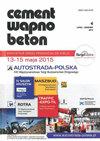Ferrophosphorus aggregates shielding properties on heavy concrete exposed to gamma-rays, cesium-137 source
IF 0.6
4区 工程技术
Q4 CONSTRUCTION & BUILDING TECHNOLOGY
引用次数: 0
Abstract
This study aims to investigate the linear attenuation coefficient and density of samples made of ferrophosphorus and typical aggregates, steel powder, and nanosilica powder in different ratios. Therefore, 60 concrete samples with dimensions of 15×15×15 cm and different contents of the mentioned materials were prepared. After the density was measured, the linear attenuation coefficients of the samples were measured by gamma radiation emitted from the cesium-137 source. The results showed that ferrophosphorus was the most effective factor in increasing the linear attenuation coefficient and the density of the concrete. After ferrophosphorus, steel and nanosilica powder – although much less than ferrophosphorus – increased the density and linear attenuation coefficient. The sample made of 100% ferrophosphorus aggregate and 20% steel powder without nanosilica powder had the highest density of 4395 kg/m3, and the sample made of 100% typical aggregate and 10% steel powder, without nanosilica powder, had the lowest density equal to 2269 kg/m3. The highest linear attenuation coefficient – 0.295 was related to the sample made of 100% ferrophosphorus, 30% steel powder, and 5% nanosilica powder. The lowest linear attenuation coefficient – 0.151 was related to the sample made of 8% nanosilica, without the ferrophosphorus and steel powder. The results indicated that the concrete density was directly correlated with the linear attenuation coefficient.磷铁聚集在暴露于伽马射线、铯-137源的重混凝土上的屏蔽特性
本研究旨在研究磷铁与典型骨料、钢粉和纳米二氧化硅粉按不同比例制成的样品的线性衰减系数和密度。因此,制备了60个尺寸为15×15×15 cm的混凝土样品,样品中上述材料的含量不同。密度测量完成后,用铯-137源发射的伽马射线测量了样品的线性衰减系数。结果表明,磷铁是提高混凝土线性衰减系数和密度的最有效因素。在磷铁之后,钢和纳米二氧化硅粉-尽管比磷铁少得多-增加了密度和线性衰减系数。100%磷铁骨料和20%钢粉混合而不含纳米二氧化硅粉的样品密度最高,为4395 kg/m3; 100%典型骨料和10%钢粉混合而不含纳米二氧化硅粉的样品密度最低,为2269 kg/m3。100%磷铁、30%钢粉、5%纳米二氧化硅粉的线性衰减系数最高,为0.295。当纳米二氧化硅含量为8%,不含磷铁和钢粉时,线性衰减系数最低,为0.151。结果表明,混凝土密度与线性衰减系数直接相关。
本文章由计算机程序翻译,如有差异,请以英文原文为准。
求助全文
约1分钟内获得全文
求助全文
来源期刊

Cement Wapno Beton
CONSTRUCTION & BUILDING TECHNOLOGY-MATERIALS SCIENCE, COMPOSITES
CiteScore
1.30
自引率
28.60%
发文量
0
审稿时长
>12 weeks
期刊介绍:
The Publisher of the scientific bimonthly of international circulation, entitled "Cement-Wapno-Beton" ["Cement-Lime-Concrete"], is the Fundacja Cement, Wapno, Beton [Foundation Cement, Lime, Concrete]. The periodical is dedicated to the issues concerning mineral setting materials and concrete. It is concerned with the publication of academic and research works from the field of chemistry and technology of building setting materials and concrete
 求助内容:
求助内容: 应助结果提醒方式:
应助结果提醒方式:


